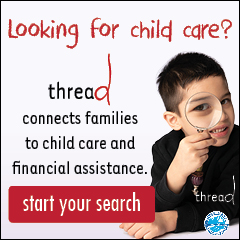ask the expert
the early years
Quick Links:

My toddler is a runner. As soon as we arrive anywhere, she takes off running. If I chase her, she looks back at me laughing and runs faster. How do I deal calmly with this while keeping her out of danger?
This is a great question many parents ask, and there are several things she might be trying to tell you. Here are a few things to try next time:
I wonder if they are looking for you to come play with them. Young kids crave relationships, the looking back at you and laughing sounds like they want to play. Frontloading play time with your child makes it much easier when it’s time to discipline. You can make a game of it by catching your child and say “Oh, we don’t run here, I’m going to catch you and bring you back” and playfully bring them back to the area you want them to run in.
Redirect them. Try playing in a different area or bring a toy that can be used at the playground-a spoon to dig with, a cup for scooping, a ball or Frisbee to throw and roll, bubbles, a container for catching bugs, or turn the game around and say, “you catch me!” and turn to run the other way, bringing the child with you.
Ignore the unwanted behavior. Move yourself to a different area while saying “I’m not going to chase you, I’m going to go play over here, come play this with me!” Keep an eye on them to ensure safety and intervene if they are headed towards something unsafe. When they come back to play with you, praise the behavior and begin playing together.
Set expectations ahead of time. It’s very normal for toddlers to exert their independence and constantly test limits. Setting expectations might take some thinking on your feet as to what area/s you are comfortable with having your child play in. For instance, “When we get to the playground you may run around between the slide and swings. If you run away, then you hold my hand (or ride in the stroller, etc).” Highly praise the behavior you want to see over and over. When they run away, kindly but firmly follow through: “Uh-oh you ran away, you need to hold my hand” (you may need to pick them up to help them be safe). When they have calmed down, let them go explore and play again, and praise the behavior.

Rachel Boudreau, LMSW, works for Help Me Grow Alaska part time and is a mental health therapist part time. Rachel has been working with children and families for 13 years and has experience in special education, children’s behavioral health, coaching teachers, and supporting family systems.

I’m going back to work and want to find the best child care facility I can for my 2-year-old. What should I be looking for when I’m researching facilities?
Choosing high-quality early childhood education can be difficult, and is often an emotional decision to make for your family.
When looking for child care, many families begin by assessing their schedule, location, budget and the specific needs of their child. With those factors in mind, it’s important to visit and interview potential child care programs to find the best environment for your child.
During those visits, here are some important questions to ask:
- Is the program licensed in Alaska? Licensed programs meet state standards and regulations, and have History Compliance Reports available to the public.
- What type of training or education does the early educator have to promote a safe and nurturing connection with my child?
- Does the program offer a playful learning environment with age appropriate toys, books and curriculum?
- Does the program offer nutritious food options and time outdoors?
- Is the program enrolled in Learn & Grow, Alaska’s Quality Recognition & Improvement System? (Learn more here: threadalaska.org/learn-and-grow-home)
You may also consider the different types of programs available in Alaska. Child Care Center programs are facility-style environments with children separated by age groups, and with multiple early educators on-site. Family In-Home Child Care programs are in a licensed and monitored private residence with a small multi-age group of children, and with one or two early educators to support them.
Also, child care can be costly for some families. There are resources available to help make it more affordable for eligible families. The State of Alaska offers an income schedule and calculator, and information about available support to help with your planning.
CHILD CARE RESOURCES
Tools for Finding Quality Care
• thread: threadalaska.org/thread/families/choosing-quality-care
History Compliance Reports
• Municipality of Anchorage Child Care Licensing: 907-343-4758, hhs.muni.org/cac
• Outside of Anchorage, contact Child Care Program Office: 888-268-4632, ccpo@alaska.gov
Child Care Assistance
• Child Care Assistance: dhss.alaska.gov/dpa/pages/ccare
• Cook Inlet Tribal Council Subsidy: citci.org
• Military Affiliation Subsidy: childcareaware.org/fee-assistancerespite/military-families

Tamora Harding-Childs, M.Ed, is the Early Childhood Development Specialist at thread. She is a lifelong Alaskan serving communities across the state through family services at thread (since 2009), Help Me Grow Alaska, and as a visual artist for over 20 years. Visit threadalaska.org.

We’re wondering about the importance of a child’s ‘baby teeth.’ Since these teeth will fall out anyway, do they require the same care and attention as permanent teeth? Also, when should parents schedule their child’s first dental check?
This is a very common and good question! “Baby teeth” serve many functions and are vital to your child’s health and development. They help your child speak more clearly and quickly, smile, and chew food more properly. They also hold the space for the permanent teeth that will eventually replace them. If a baby tooth is lost too early, other teeth can drift into this space and cause crowding, or even block an adult tooth from coming in. Even if a “baby tooth” is not lost too early, if it has a cavity, its size is reduced. These teeth can drift into each other essentially causing less space to be reserved for the permanent successors, resulting in crowded and crooked adult teeth.
Unfortunately, baby teeth can also cause pain when they get cavities. This can make it difficult for your child to sleep, affect their behavior and ability to pay attention in school, and even learn to speak. If infection develops, it can be a medical emergency. This is why the American Academy of Pediatric Dentistry recommends that each child has an established dental home by 12 months of age. It will ensure your child receives the appropriate preventative and oral health care, and help set the stage for a lifetime of good habits that can protect their teeth in the years to come.

Dr. Easte Warnick is a Board Certified Pediatric Dentist, and a member of the American Academy of Pediatric Dentistry and the Alaska Pediatric Dental Society. She is a pediatric dental specialist at Anchorage Pediatric Dentistry. Visit anchoragepediatricdentistry.com.

Our toddler acts shy in social situations. People around her might try to help by saying, “Don’t be shy” or “Has the cat got your tongue?” but these reactions seem to increase her anxiety and make her more self-conscious. Any tips for ways we can encourage her to feel more comfortable and gain confidence?
Every toddler has a different level of comfort with people. Some toddlers are very social and have no difficulty joining social situations, while others may be more reserved. It can be hard to see other toddlers joining social situations without hesitation when your toddler is hiding behind the adults. Being shy is part of the spectrum of normal development and helps your toddler assess if a situation is safe. However, that doesn’t mean there are not things you can do to help encourage more social behaviors from your toddler.
When you and your toddler are with other toddlers or people, participating in the play yourself can help your toddler feel more comfortable joining the group.
Coaching your friends and family that your toddler needs a little time to warm up may help. Encourage them to give your toddler space, then after a bit of time have them engage in one of the toddler’s favorite toys to try to entice the toddler to play.
Reassuring your toddler by stating it is okay and she doesn’t have to join, can help normalize the feelings and reduce anxiety.
Remember to be patient. Your toddler is now developing her personality which may be more reserved or shy.
Encouraging your toddler to try new things while moving at her pace is important. When your toddler does join others in play or engages with adults, praising the positive behavior is important. Acknowledging positive behaviors will increase the likelihood of the toddler doing it again, and decreases her experience of anxiety. 
Rachel Cooper, MSW, LCSW is the Chief Clinical Officer at AK Child & Family. Rachel has 13 years of experience working with children and families.

Ah, the dreaded public tantrum – we’ve all been there, right? It’s hard to ignore a toddler having a meltdown in the supermarket or restaurant, so what is the best way to handle these moments outside of the home?
Oh how embarrassing and anxiety provoking those public meltdowns are! We think all eyes are upon us, criticizing our child’s BIG upset and judging how we handle it – and often that means how we are going to STOP it.
Toddlers developmentally are learning to be increasingly in charge of themselves. This includes how to express and manage their feelings. Tough to do when you’re 2! It takes time and a calm, connected parent willing to learn right alongside them.
How we decide to respond to our toddler lost in their big feelings determines what is learned – both in the moment and for the next time around. The goal is to be the positive, trusted influence they need to grow a little bit more in healthy and productive ways.
The how? It begins with a PAUSE.
Take a few deep breaths, maybe close your eyes briefly. Use encouraging self-talk to remind yourself this is an opportunity to let your toddler know they can count on you to keep it together even as they totally lose it. What a way for them to feel safe in the midst of those BIG feelings! Trust your understanding of your child as you decide if they need you next to them or picked up and taken to a quieter place. Then respond from this calmer place a PAUSE can bring – even if you are “acting-as-if”!
It is okay to leave a grocery cart in the store and head out to the car to get a change of scenery and feel better with fewer eyes upon you. It is okay to stay next to your little one with your hand on them, talking softly or not at all – what a way to communicate your confidence in their ability to work through their upset. It is okay to let them finish their cry as you finish (perhaps quickly!) what you are in the middle of.
PAUSE. Calm yourself, first. Respect those BIG feelings by giving your child the safe space to express them. Discover what works best for them to finally settle. Know that as you work at keeping yourself calm you are helping your child do the same.
And then remember, go take care of YOU and your feelings.

Alice Hanscam is an author and PCI Certified Parent Coach who has worked with parents and children for 40 years, delighting in supporting, encouraging and inspiring parents so their relationships can thrive. Visit denaliparentcoaching.com.

Now that our child is learning to read, what are some ways we can help her get excited about reading and encourage her to appreciate books? Any tips for nurturing a love of reading that can last a lifetime?
At this important milestone, I suggest selecting books that have simple, repetitive words, yet still grab the reader. Typically these easy reader, or early reader, books have illustrations on every page and are character driven. Look for books that contain words your child is learning, so that the child may be able to read the entire book.
Some easy reader publishers indicate the level of reading on the spine and cover of the books. However, be aware that publishers may use different ranges when indicating their reading level, and parents can assist by looking over the book to make sure it is appropriate to their child’s ability. Parents can also help their child take ownership of his or her reading by preselecting several books and allowing the child to pick out a couple of their favorites to read.
As your child grows, it is important to allow them to select books that they are interested in, especially when motivating reluctant readers. Of course, a fun trip to your local library is always nice; spend time there, enjoy reading a book together and explore the library’s reading programs.
One of the healthiest hobbies my family began when my children were learning to read was to establish a time in the evenings where we all spent 20 to 30 minutes reading before bed. Children notice when parents spend time reading and see this activity as customary. The child can read silently to themselves, read out loud to their caregiver or sibling, or you could read a book to your child. This is a wonderful intimate time to cuddle up with your child and explore the wonderful world of books together.

James Adcox has served as a Library Assistant and Youth Services Coordinator for the Kenai Community Library for three years. James leads weekly story times, implements summer reading programs and develops children’s programming for the library. Visit kenailibrary.org.
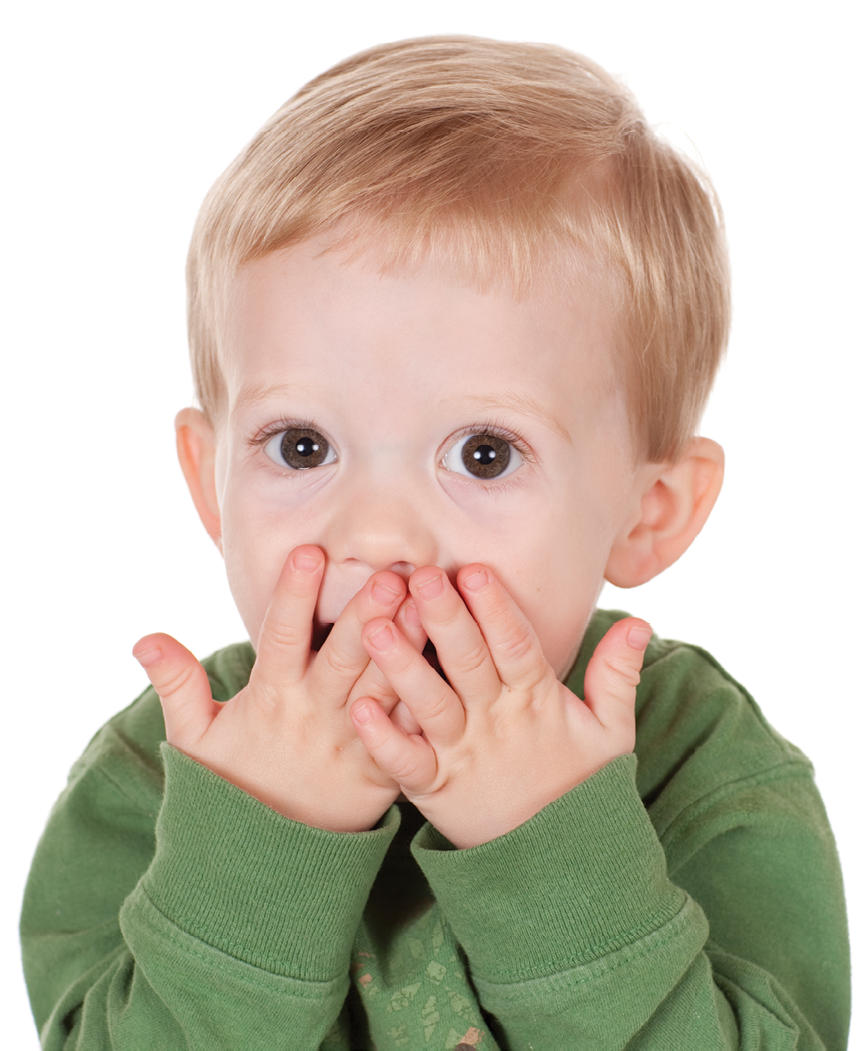
My preschooler has picked up some foul language and has been using his “potty mouth” at very inappropriate times. He doesn’t really know what it means, but he likes getting a reaction. What is the best way to deal with this?
Potty language coming from the mouth of your preschool-age child can be a frustrating and challenging thing to deal with. Where did they learn this? Why do they find it so funny? The truth is, your child probably doesn’t know what they’re saying, but they do know that it gets a reaction out of you! Because this type of behavior is typically attention seeking, it is your first line of defense to NOT REACT. Do not smile, laugh, gasp or raise your voice at them. Simply correct them calmly with a straight face by saying, “People don’t like that word, so we don’t use that word.” Discuss appropriate words and making the right choice when your child is calm and more attentive; it is much easier to teach skills ahead of time, as opposed to correcting a behavior in the moment.
Often times, we are inclined to ask our child, “Where did you hear that word?” As difficult as it may be to accept, sometimes our children hear these words from us; it’s okay, you are human too. Limit your child’s exposure to television and music that has foul language, and create a family standard of holding one another accountable for using clean language. Allow your child to “correct” you if you accidentally swear in front of them.
Sometimes children like to use foul language at inappropriate times. Typically, an “inopportune moment” is one where you, the parent, are preoccupied, perhaps talking to another adult, checking out at the grocery store or driving your vehicle. This is just one of the many reasons why it is important to ensure your child receives an abundance of positive attention. Praise them when they choose to use clean language or substitute a “bad” word for a fun replacement word like, “darn!” Remember to always be a positive role model, and don’t be afraid to show your child how to express their feelings without swearing.

Karlene Harris is the Program Administrator for Bright Beginnings Early Learning Centers. She has worked in early childhood education for approximately 10 years and holds a National Administrators Credential from the National Institute of Child Care Management. Visit brightbeginningselc.com.
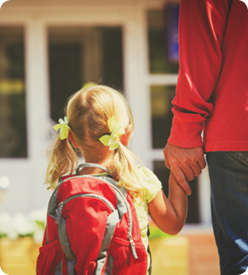
Our child will be starting daycare and I’m worried about germs being passed back and forth! Do you have any tips for keeping our family healthy, so we are not stuck in a cycle of sickness? Should we talk to the daycare teacher about germ prevention?
Parents have many concerns about putting their child in daycare. How will he go down for his nap? Will she take a bottle from a stranger? What if their schedule is different from what he is used to at home? The biggest worry, however, is that it is inevitable that your child will be exposed to “germs,” despite the best efforts of daycare staff. My recommendations would be the following:
- Make sure your child is up-to-date on his vaccines, including the annual influenza vaccine (“flu shot”).
- Parents and all close contacts should also be up-to-date on their vaccines.
- Do not take your child to daycare if he/she is sick so as not to expose other children as well as to give your child the opportunity to rest and recover quickly.
- Give your child a bath/shower as soon as you return home. If this is not possible, wash his hands and face and change his clothes. Teach your child to wash his hands frequently, especially before eating.
- Talk to the daycare about their policies on when children are sent home and when they can return.
- Good nutrition, regular physical exercise, and adequate sleep all contribute to a good, healthy “base.”
Germs are ubiquitous. Children will eventually be exposed to them, whether it is at daycare, at the park, at the store, on the plane, or at school. Prevention is number one. Do not hesitate to contact your child’s pediatrician if you have any questions or concerns.

Dr. Janet Shen is a pediatrician at The Children’s Clinic. She has practiced at TCC since her arrival to Anchorage 23 years ago. She is a mother of three children, her daughters are both in graduate school and she has a son in college. Visit tccpeds.com.

My toddler sometimes hits me when he’s upset or frustrated – and it can be embarrassing in public. This aggression also makes me feel like I’m failing as a good parent. Is this behavior normal and how should I be responding?
While it can be embarrassing, it is very normal for toddlers (12 to 36 months) to engage in physical hitting. Between their underdeveloped verbal skills, desire to be more independent and immature impulse control, children within this age group are prime candidates for hitting, biting and kicking. Of course, that doesn’t mean it should be ignored. Staying “cool,” telling your child that hitting is not okay and using a short time-out (just a minute or two) are good ways to begin to address this behavior. Yelling, telling your child that he or she is bad or spanking the child will most likely encourage more of the undesired behavior. Remember, they learn more from how we act than what we say.
One of the best methods I have found for addressing this behavior is to catch them when they are behaving well. The next time your toddler shows even an ounce of patience, waiting her/his turn, show some restraint when waiting for a snack or accepting the answer “no,” be sure to acknowledge this behavior and let your toddler know how much you appreciate it. Help them to understand that it is okay to have angry feelings but that it is not okay to show them by hitting, biting or kicking. This can help them understand that hitting is inappropriate and learn that if they do fall back into aggressive behavior, they must always apologize. Recognize that an apology might be insincere at first, but the meaning will eventually sink in.
Finally, one of my favorite tricks to help with this subject is the children’s book Hands Are Not for Hitting by Martine Agassi. Making this book and others like it one of the bedtime stories you read to your child at night can help reinforce your teaching and, ideally, shorten the time you will need to tolerate this behavior.

Denis McCarville is President and CEO of AK Child & Family. He has 40 years of experience helping children and their families deal with their emotions and change their behavior. For more info, visit akchild.org.

As parents, how do we explain dramatic, disturbing news (that often leaves us speechless) to our 5-year-old? From natural disasters to mass shootings, the wall-to-wall coverage is hard to avoid. What are some ways to talk to young children and help them deal with this information without adding to any fears?
There are six things that you can do as a parent to help your young child deal with dramatic and disturbing events.
First, limit exposure. While you can’t completely shield your child from exposure, you can limit it. Simple things like turning off the television can help. The content and frequency of disturbing news available in our media culture is overwhelming for young children.
Second, talk with your child about what they do see or hear. Explain what they see using words they understand. Children need us to help them process what they see and hear.
Third, encourage them to ask you questions. Young children often personalize what they see. If they see news about a school shooting, they think it will happen at their school.
Fourth, provide reassurance. Let them know what you and other adults (teachers, friends, neighbors, firefighters, police) do to keep them safe.
Fifth, listen to your child, especially their feelings. Acknowledge their feelings while also providing reassurance.
Finally, take care of yourself. Give yourself a break from the disturbing news. Children tune in to us more than we know. They are looking to us and are impacted by our emotions. When we are anxious or overwhelmed, it affects our children. We adults are impacted by these things too, and taking care of ourselves helps us take care of our children.
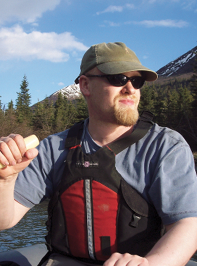
Joshua Arvidson, MSS, LCSW is the Director of the Alaska Child Trauma Center and Early Childhood Services at Anchorage Community Mental Health Services. Visit acmhs.com.

It’s happened. My 3-year-old has decided he will eat only a few foods: bread and cheese, chips, fruit snacks and apples. We’re concerned he’s missing out on some important nutrients. We’ve tried to convince (and yes, bribe) the little guy, but he’s not giving in. So, what should we be doing during this very frustrating food rut?
Remember the saying, “You can lead a horse to water but you can’t make him drink”? The same is true for your preschooler. He needs to show you that he, and only he, is in charge of what he eats. Just remember, your job is to provide nutritious foods, his job is to decide to eat it. The more we bribe, beg and negotiate, the more he is going to push. Instead, offer the food and make sure you state (and believe… and follow through) that what is being offered for the meal is it. I’m a mother, and when my oldest hit this stage, I found it really, really hard to not want to cater to his menu changes, naturally being worried that he simply wasn’t getting the right nutrients. So, to make it work for both of us, I had something nutritious on his plate each night that I KNEW he wouldn’t turn down, like yogurt, a cheese stick or some fruit. Sure enough, he’d gobble that down and then insist that he wanted something else besides what was left. Knowing that he had at least some food in his belly, I felt comfortable stating that what was there was what he got and reiterated that he got to choose if he wanted to eat it.
Sometimes, just outlining that he is in control of that decision is enough for him to suddenly dive in and eat it. Sometimes he chooses to be done, and when that happens, I just remind him that there won’t be a snack later. Amazingly, this works! All children go through food rut stages. Your ability to stay the parent and weather this storm like any other phase in development will help him feel more in control of what he gets to eat. Then, as soon as it started, it’ll be over, and he’ll go back to increasing his food repertoire. Until then, make sure the choices you offer are nutritious, remind both yourself and your child that you choose what food to offer, he chooses what food to eat and you’ll both quickly be on to the next exciting phase.
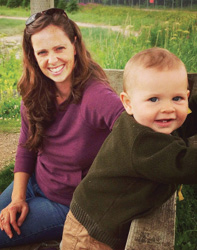
Emily Thompson is the Parents As Teachers Manager for the Association for the Education of Young Children, Southeast Alaska. She is the mother of two children under the age of 5 and has her BS in Early Childhood and her MEd with a focus on Montessori Education, birth to 3 years. aeyc-sea.org

How does early music education affect a child’s learning ability? Would it be beneficial to our 3-year-old? Can he take ‘formalized’ lessons at this age?
Making music should be a part of everyday life, especially for the young child. Our westernized culture has changed the music world into a “leave it to the performer” scenario, which turns us into consumers and not music makers. But, in doing this, we fail to hand our young children the tools to explore music in a form of social play and develop what we call “musical babble.” The pathways in our brains that are forming as a young child develops spatial awareness and fine motor skills can only be continually strengthened and developed with the ability to make music. Lili M. Levinowitz and Ken Guilmartin, co-founders of Music Together LLC, say this: “...like language development, young children develop musically through a predictable sequence to basic music competence, which includes singing in tune and marching to a beat.” Every child is musical. We are all wired to make music, and the neglect of making music can only aid in the atrophy of ability.
Making music, in whatever form and at whatever age, is always a benefit to the child’s mind and body. A baby may kick her feet and babble to the music; a 3-year-old may sing in tune; and a 5-year-old may stomp and clap to the beat of the song. Whether those children are in “formalized” lessons is not necessarily the key to success. It is the ability to provide your child with the safe space to learn music, love music, and make music with the freedom to express themselves how they choose.
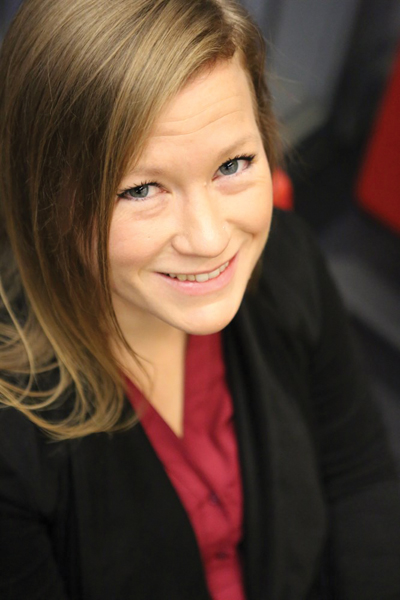
Hannah Marx Smith is the Center Director of Timbre Music Studio offering Music Together LLC classes for ages 0-5 and an accompanying adult. Visit timbremusicstudio.com.

We’d like to get our 4-year-old involved in gardening this summer so she can learn more about how plants grow and where food comes from. What are some pint-sized projects that would be fun and easy for her to tackle in the garden?
Make the garden a place of joy. Planting is fun but before even heading out to the garden, germinate seeds indoors. Bean seeds are big and easy to handle. They are especially spectacular when they germinate. Put the seeds on a moistened paper towel sheet. Roll them up and place in a plastic bag that you keep on the kitchen counter. Five to seven days later, I guarantee you will hear a huge exclamation of surprise when you unroll the paper towel to see if the seeds have sprouted.
Kids love dirt and rocks. Make sure to involve him or her in preparing the garden soil. Get child-sized gloves and tools, and let your budding gardener get dirty. A bucket becomes an indispensable tool. It can be used for picking rocks, moving soil or adding compost. Make sure it’s the right size for your child to handle.
Lay out garden pathways and plant in beds so that your youngster doesn’t have to worry about where to walk. Beds can be raised by raking soil from path areas. When the two of you plant, you make the holes for seeds to control spacing and let your child drop in the seed. Switch jobs when planting in furrows. You sow the seed and let your son or daughter pat soil over the top.
Your child will learn to garden by being in the garden with you. No good plant, bad plant lessons at this age. Weeding and thinning are out. Visit the garden regularly, especially when not planning to do any work. See if there are any butterflies or other pollinators present. Check on how tall the peas have gotten.
Exploring for vegetables that are ready to pick will teach your child where food comes from. When you’re a 4-year-old, digging for potatoes is like digging for gold. The best part? Children who grow their own veggies are more likely to eat them – a great way to sow the seeds of healthy eating.

Julie Riley teaches gardening for the University of Alaska Fairbanks Cooperative Extension Service. Children have helped her to experience the garden from a fresh perspective.

We’ve all witnessed a toddler screaming in a restaurant or acting out while food is on the table. Now that our daughter is entering toddlerhood, what are some ways to not only prevent this bad behavior at dinnertime, but also teach her to have good table manners?
![]() Dining out with young children can be quite challenging, but it can also be fun! Come prepared with activities and options for your toddler. Toddlers are entering an age in which independence is realized and deeply desired; offering a toddler choices is a fantastic way to engage their interest while instilling a sense of self. Prepare easily manageable table activities ahead of time, and organize them in large Ziploc bags that slip easily into your diaper bag. Activities such as laminated sheets of paper with dry erase markers, lacing sheets with yarn, counting and sorting activities and books are just a few suggestions. We like to call these “busy bags”! It is important to keep your child occupied at the table as you wait for your food to arrive; boredom results in acting out.
Dining out with young children can be quite challenging, but it can also be fun! Come prepared with activities and options for your toddler. Toddlers are entering an age in which independence is realized and deeply desired; offering a toddler choices is a fantastic way to engage their interest while instilling a sense of self. Prepare easily manageable table activities ahead of time, and organize them in large Ziploc bags that slip easily into your diaper bag. Activities such as laminated sheets of paper with dry erase markers, lacing sheets with yarn, counting and sorting activities and books are just a few suggestions. We like to call these “busy bags”! It is important to keep your child occupied at the table as you wait for your food to arrive; boredom results in acting out.
Meal time is an opportunity for fellowship. When possible, enjoy meals served family style, so that the child is able to choose what is put on their plate and how much. A child’s interest in a meal grows tremendously when they are involved in the process. While serving or enjoying your meal, keep your child focused and engaged by talking with them about the food you are eating, where it came from and how it was prepared. Lead by example and demonstrate the table manners and positive behavior you expect from your child during social meal times. Remember to say please and thank your wait staff throughout the dining experience, encourage your child to do the same and speak with your voice at the same volume you expect them to speak at. Go prepared and public dining experiences with your child will be fun, exciting and educational!
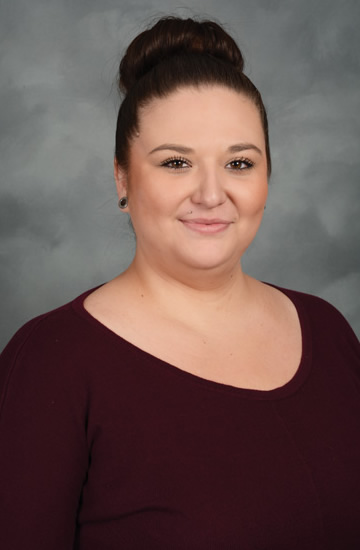
Karlene Harris is the Program Administrator for Bright Beginnings Early Learning Centers. She has worked in early childhood education for approximately nine years and holds a National Administrators Credential from the National Institute of Child Care Management.
Visit brightbeginningselc.com.
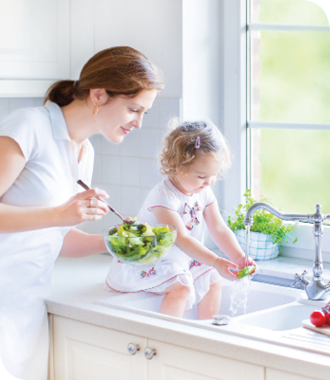
When I’m trying to put together lunch or make dinner, my toddler is always climbing up my leg and it’s hard to get anything done with one arm. How can I get her involved in the kitchen? Are there any appropriate tasks she can handle at that age?
Mealtime can be one of the hardest times for toddlers and their parents. Children are hungry and parents may feel rushed. It is great when you can turn this around and make it fun. Preparing food together is a great way to spend meaningful time together. A first step is washing hands together to make sure your toddler begins with clean hands. Find a stable place for your toddler to work while you supervise. There are many things they can do to help in the kitchen:
-
Wash vegetables and fruit.
-
Cut soft fruits and veggies with a butter knife.
-
Tear lettuce, spinach and kale.
-
Help set the table.
-
Talk with you about what you’re making.
-
Fill measuring cups with ingredients.
-
Mix ingredients.
-
Spread jam or mayonnaise on sandwiches.
Before the meal, they can help you shop for ingredients. Toddlers can fill bags, practice counting with produce and find items on your shopping list. They can even help you grow a small container garden with lettuce or fresh herbs.
Of course, keep the little ones away from the stove/oven and knives. Sometime it really just does not work to have help in the kitchen for safety reasons or maybe you are in a rush. Try to have supplies handy at those times to engage your children in other activities they can do nearby while you work, like play dough, coloring crayons or building blocks.
Now that you have worked so hard together to create a meal, be sure to eat as a family. Turn off distractions and spend some time talking to each other. Many studies show that mealtime with families can help a child’s development.

Kari van Delden, M Ed., is an assistant professor with the University of Alaska Fairbanks Cooperative Extension Service. She works as the agent for Health, Home and Family Development and Youth Development programs for the Northwest District based in Nome.
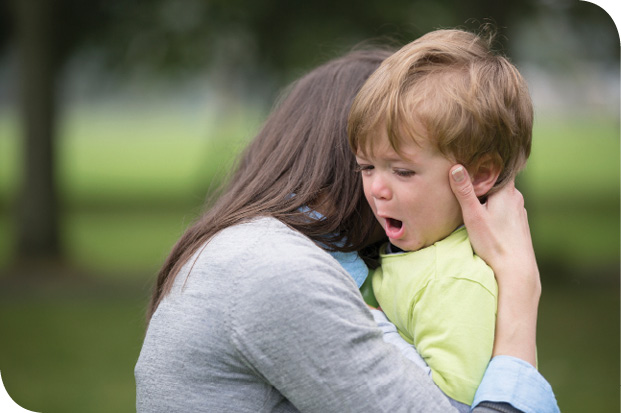
My husband and I are concerned about our 2-year-old’s behavior. While on a recent playdate, he decided to embed his teeth in his playmate’s arm. We were horrified but not sure how to discipline our pint-sized vampire. Why do toddlers bite and what’s the best way to deal with the situation?
The good news is you don’t need to stock up on cloves of garlic to ward off a potential toddler vampire. You may be surprised to learn biting is a typical behavior of young children due to their lack of communication skills, impulsivity, and oral needs to relieve pain from teething. Knowing your toddler bit a friend on a playdate makes me think he was trying to communicate feelings of frustration or being threatened. He didn’t have the skills yet to calmly tell his friend, “Wait, I had that first,” or “Excuse me, you’re in my way,” so he used biting to convey this message.
To stop biting, you may have gotten the advice to bite the child back, but I disagree with this as it reinforces biting as an acceptable behavior. Instead, use the following strategies to prevent this behavior:
• Positioning yourself close to the children to have the ability to intervene quickly.
• State rules positively by saying “Teeth are for chewing food.”
• Ensure snacks/meals are offered frequently and include a variety of textures to chew.
• Provide items the child can chew on, such as teething toys or frozen wash cloths.
• Redirect biting to the appropriate item they can chew.
• Read to the child simple board books about biting.
Another strategy to use when your son bites again, because it will happen, is to focus the attention on the child who was bitten rather than give negative attention to your son. You can tell him “biting hurts” and include him in caring for his friend so he will eventually learn empathy for the child who was injured.
Understanding what occurred prior to the biting helps you recognize what may have influenced the behavior and allows you to view the behavior as age appropriate. If the biting increases in frequency, it may help to document what occurred along with the date and time. You may be able to find patterns, such as biting occurs shortly before lunch because he’s hungry. This information can further support you in preventing biting in the future.

Cassie Hulse, M.Ed, has been involved in the early education field for over 25 years and in addition to a master’s degree in adult education has an undergraduate degree in early childhood. Currently the Director of Professional Development at thread, Cassie advances the quality of early care and learning through training and consultation services for those working in the early education field. Visit threadalaska.org.

My toddler is always shouting “Mine!” as she grabs any and every toy from her playmate. I’ve told her that she can’t keep all the best toys to herself when she’s with other kids, but she doesn’t seem to get it. How can I teach her to share?
Given that each child is different, here are some strategies that may prove helpful.
Talk it through. Have a conversation with your child about how they feel when someone takes a toy from them. Do they like it? What do they want to happen when a friend takes a toy from them? How do they feel about the friend? About the toy? Explain that we don’t take toys from our friends when they are playing with them. The child may not like sharing, or want to share, but we all have to share, even as adults.
Take turns. Set a time limit for each child to take turns with the toy. If they each know that in two minutes the favorite toy will be theirs again, they will watch how the friend plays with the toy and try playing in different ways with the toy when it is their turn. Maybe the kids can play together with the toy. If the favorite toy is a car, maybe they can each have a car and play cars together, taking turns with the favorite.
Distract or redirect. When it is the other child’s turn with the toy, give your child a different toy or activity to do while they are waiting for their turn. Sing a song or read a book to keep your child actively engaged instead of focused on their friend playing with the toy.
Practice, practice, practice. Have your child practice sharing every day. If your child is an only child, have them share their toys with friends, dolls, stuffed animals, adults – anyone, EVERYDAY. Consistency is key.
As with all things related to children, please remember that this is just a stage. This too shall pass. Soon you will have a new challenge to overcome with your child.
_ppEMAIL.jpg)
Marcy Richards lives in Eagle River and is the mother of three girls, ages 10, 4 and 19 months. She is Co-Director of the Joy Greisen JEC which provides infant and toddler care, preschool, pre-K, camp and after-school for children ages 3 months to 15 years. jecalaska.com

My 3-year-old is just starting to show an interest in arts and crafts, and I’m eager to encourage her creativity. Do you have any suggestions for activities that we could enjoy together?
There are several ways you can encourage creativity with your toddler through playful activity. Crayons and watercolors are perfect for this age. Scribbling is our very first communication, even before words. As adults, we tend to look at scribbling as a waste of paper, but if you consider that art is motivated by emotion, your child’s scribbles will begin to communicate her feelings to you. When a child finishes a picture, instead of asking, “What is it?” use a more open-ended question, such as “Tell me about your picture” to encourage communication. I would also suggest getting a pair of safety scissors and showing your toddler how to use them – with their thumb through the top loop, little fingers in the bottom loop – and make chomping noises as the scissors open and close. You can add a level of difficulty by drawing wiggly, jagged lines or circles on paper and having them cut on the lines. Once your budding artist feels confident with these activities, you can combine them to make projects! One project idea is to glue down bits of paper to create a collage, which is a precursor to a mosaic. If you sprinkle sea salt over a wet water color painting, the salt will draw the color in and create an interesting effect. Circles can become faces, squares with a triangle on top become houses. Enjoy this time with your toddler and embrace your creativity while you help foster hers!

Jennifer Stratton is the owner of Kaleidoscape Play Studio and a nationally recognized Play Advocate. Her mission is to strengthen families through playful activity in a space where creativity is more of a focus than rubric. kplaystudio.com

My 3-year-old daughter is interested in helping with chores, but the jobs she wants to do – washing the dog and vacuuming – are too big for her. What are some tasks that are just the right size?
What a great question! There are many jobs around the house that your 3-year-old daughter can take part in. These small tasks can help her feel included in daily activities and can help build her self confidence and self-help skills.
I would suggest looking at your daily schedule and incorporating small tasks or chores into a routine. In the morning small tasks may include putting PJ’s in the hamper or helping set the table for breakfast. At lunch time she could help spread peanut butter on the bread or take dishes to the sink when done eating. In the evening she could scoop food into the dog’s bowl or help water house plants or the garden outside.
Get creative in thinking of ways of including her in your activities around the house. If you are folding laundry, she could help fold two socks together and then throw the socks into the laundry basket. If you are vacuuming the floor, maybe there is a small broom that is reserved just for her so that she can sweep while you vacuum. The more she feels included in daily activities the more her self confidence and self-help skills will grow. And remember to have fun! The more we can turn parts of our daily routine into a fun time spent with our kids the better!

Anna Maguire is a Certified Home Visitor in the Parents as Teachers Curriculum and Parenting Coach at the Resource Center for Parents and Children. For information, visit rcpcfairbanks.org.

We’re planning to take a long flight with our very squirmy toddler. Any tips (or tricks) for stress-free flying with our tiny traveler?
Flying with small children is going to be stressful, no matter how well-prepared you may be, but there are a few tricks parents can deploy, especially for long flights.
First, consider purchasing your small child (under 2) his or her own seat. While the cost may seem prohibitive, it may pay off in the long run with a toddler who understands the “car seat rule” and remains relatively quiet for longer stretches of time. Alaska residents are fortunate to have the option of mileage plans with companion fares and special deals; look for these at Alaska Airlines (alaskaair.com).
Pack wisely. Add more snacks than you think you’ll need, small toys like stackable cups, board books, pipe cleaners, rubber bath toys (they are durable and quiet, usually). We packed necklaces made of cereal “o’s” and passed them out at random moments. Our son also enjoyed listening to stories via portable DVD player (or tablet). Most kids have a “lovey” they will insist flies, too, and a favorite blanket and small pillow might make for a more comfortable experience. Flight attendants will do what they can to help make a trip more bearable for parents; ask for assistance if you need it.
If there are two adults in the party, have one adult take advantage of pre-boarding with car seat and extra carry-on luggage while the second adult waits behind and boards near the end of the line. Toddlers can then stretch their legs and not have to sit for nearly an hour before actual departure.
Make sure all children have something to suck on (lollipop, pacifier, bottle or nursing) during take off and landing, as pressure changes in the ears can make kids miserable, no matter their age.
Above all, remember that every single individual on that airplane was once a toddler. None of us can predict how our children will react to new situations, so stay calm, smile a lot and don’t rush. You’ll get there.
Erin Kirkland is the author of Alaska on the Go: Exploring the 49th state with children. She is also publisher of AKontheGO.com, Alaska’s only family travel resource.

I think my son has social anxiety. He went to a birthday party – with a bouncy castle, games, costumed characters and balloons everywhere – but he still wanted to stay attached to my leg instead of joining in on the fun. Should I be worried? And are there any strategies I can use to help him get comfortable in a crowd?
Some children have a more introverted personality. They are born that way. In this situation I would walk with my son to the various activities and engage the children in a brief conversation; perhaps even consider doing the activity with your son. He has fear about the interaction with peers. So without telling him to do anything, start to interact yourself so he can see that the kids won’t eat him alive. Let him see what great fun you are having joining in. He may want you nearby as he goes down the slide or enters the bouncy house. That’s okay. Remember it is gradual exposure that will do the trick; nothing sudden or harsh.

Sheila Smith has worked as a licensed clinical social worker for 25 years, treating children, adults, couples and families, and specializing in anxiety disorder. For more information, visit fairbankscounselingassociates.com.
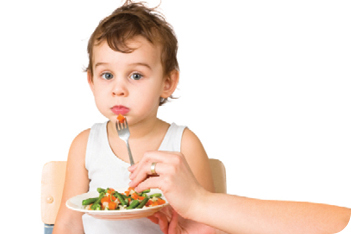
My son is a pretty good eater, but refuses to eat vegetables. What are some tips for getting toddlers to eat their vegetables?
Toddlers can be a bit frustrating at mealtimes. You want to make sure they eat nutritious foods and yet some seem to stall at every effort. Three of the most important tools you have as an adult is patience, persistence and role modeling. Offer those foods your toddler doesn’t seem to like off and on. Be careful not to make a big deal about them or create an uncomfortable atmosphere. Be enthusiastic about eating them yourself, showing delight in the color, the texture and the taste. Act it up if you want. Always ask if they would like to try just one bite but again try not to turn it into an uncomfortable situation. Avoid bribing. That sends the message that vegetables require something fun to eat them, therefore they must not be good. If you bribe with dessert, it puts more focus on the dessert rather than the nourishing vegetables. If your toddler refuses one day, it doesn’t mean they will refuse forever. Try again in a few days. Try a particular vegetable in different ways. Sometimes it is simply the presentation. Try introducing a new food or vegetable with something they enjoy.
Another tip is to avoid letting your child eat too many snacks. If they really aren’t very hungry at mealtimes they will tend to be more picky. If they absolutely refuse any vegetable, you can add shredded carrots and cabbage to meatloaf. See if a soup would be more appetizing for them. Dice the vegetables small so they are easy to manage. Add finely diced vegetables to pasta.
Again patience, persistence and role modeling in a supportive, positive atmosphere, in my opinion, are the best tools to have.

Marsha Munsell is the health, home and family development program assistant at the Tanana District Cooperative Extension Service School of Natural Resources at the University of Alaska, Fairbanks. For information, visit uaf.edu/ces/hhfd.
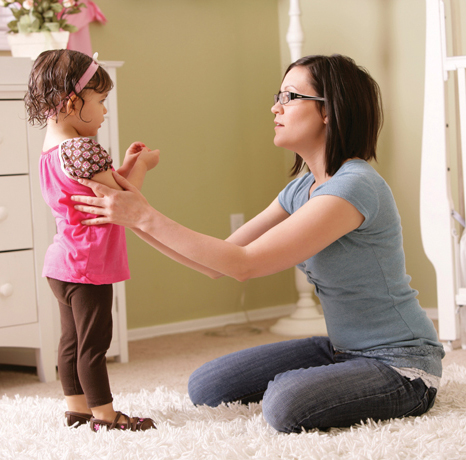
My 27-month-old daughter still hasn’t started talking, even though she understands almost everything we ask her to do. She’s smart, but should I be concerned that she might have a speech disability?
Typically children will begin saying their first words by 12 months of age. By 24 months, children usually have a vocabulary of more than 50 words, using 2-3 words in a phrase when talking with you or while playing. Although your child’s lack of speech isn’t typical, it may not be a cause for great concern. Try not to jump to conclusions such as disabilities and disorders! Some children seem to wait until they have a deep understanding of language before they begin talking. However, if you are concerned about your child’s development, contact your pediatrician. In this case, your pediatrician will direct you to a local speech-language pathologist for an evaluation. The earlier a speech delay is detected, the easier it is to treat and the greater the progress will be. In the meantime, there are some things that you can do during play with your child to help: sing songs and nursery rhymes with your child, teach animal sounds, introduce single sounds such as “b-b-b” and “mmmmmmm” during routines or while eating, and use small and simple words that are easy to repeat. It is a good sign that your child appears to understand what you are saying; this means that their receptive language, or how much of what you say is understood, may be developing normally. With your continued support, and the support from a speech pathologist, your child should begin to develop functional communication and experience no lasting negative effects.

Lindsey Kennedy, CFY-SLP, is a speech therapist with All for Kids Pediatric Therapy where she loves working with children. For more information, visit allforkidsalaska.com.
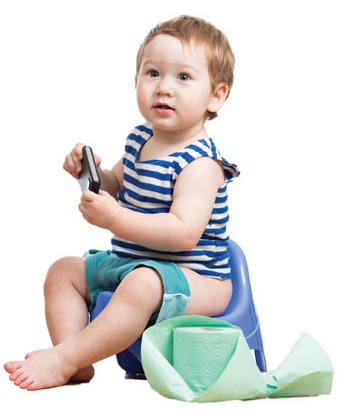
I’m trying to introduce potty training to my 25-month-old, but it seems like she feels it’s more of a punishment to be on the potty than an exciting hurdle. Is there a way I can make this a fun experience for her?
Every child is not ready to potty train at the same age. I would recommend stopping efforts to potty train her if she thinks it is punishment. Instead, praise her when she tells you she is wet or messy so you can change her as soon as possible. To get her more comfortable with the potty chair, have her sit on it (with clothes on) when you read to her. When she seems more comfortable, you can try offering rewards, but some children are just not interested until they are closer to age 3 (or sometimes older). We don’t potty train our children, they potty train themselves when they are ready.

Dr. Martin Beals has more than 35 years experience working in general pediatrics. He joined the Alaska Center for Pediatrics in May 2001. For more information, visit akpeds.com.
Easing Separation Anxiety

My child is having trouble with separation when I bring him to preschool. What are some ways I can mitigate his reaction when I’m about to leave?
It is not uncommon for children to experience some separation anxiety at drop off, especially if it is a new environment. There are a few things that you can do to ease the transition. Have conversations with your child about their preschool; for example, ask them what their favorite activity during the day is and what their favorite toy is. Use these references during drop off: “Look Sally, here is the truck you like.” Try to follow a morning routine at home and drop off at the same time each day. Let the child bring a comfort item; it could be a picture or a stuffed animal to remind them of home. Establish a routine with the caregiver so that when you are ready to say goodbye, the caregiver is able to step in and comfort your child while you leave. When saying goodbye stay calm and speak matter-of-factly: “I love you and will pick you up after you eat snack.” Try not to linger during this process as that often creates more anxiety. Resist the urge to “sneak out” without saying goodbye. Children are often more frightened and more upset when they look for you and you are gone without realizing you left. Feel free to give the preschool a call during the day to check in and see how your child is doing. Most often the child has stopped crying moments after drop off.







